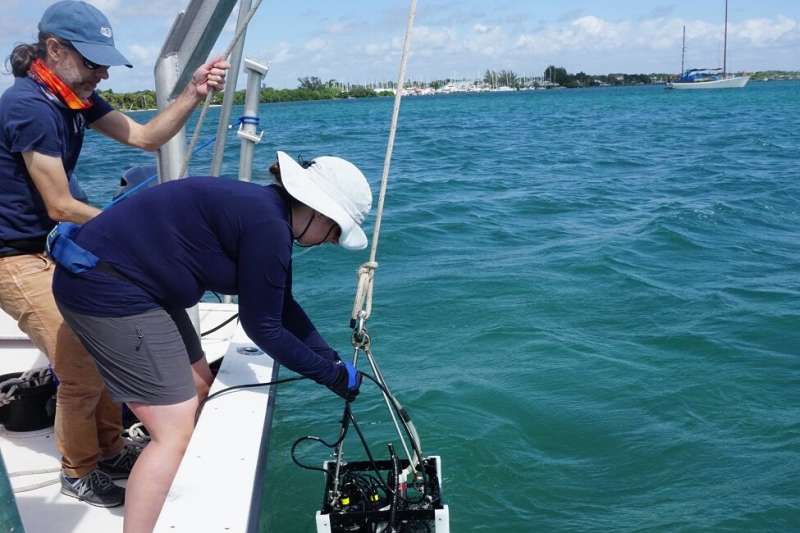How toxic is the water's surface on Florida's Indian River lagoon?

Over the last 30 years, urbanization has increased along the Indian River Lagoon, which stretches about 250 kilometers on Florida's east coast. As a result, water quality has deteriorated and there is widespread loss of seagrasses and persistent harmful algal blooms, which threaten ecological, human and marine animal health, such as manatees.
In this valuable and vulnerable system, two types of toxic blooms raise significant concerns: Microcystis aeruginosa (blue-green algae known to produce microcystin toxin) and Pyrodinium bahamense, which produce a neurotoxin called saxitoxin. Saxitoxin causes paralytic shellfish poisoning, which has caused dozens of fatal and non-fatal poisonings worldwide.
Specific health effects due to concentrations of toxins in surface water of the Indian River Lagoon are not fully understood. Researchers from Florida Atlantic University's Harbor Branch Oceanographic Institute in collaboration with the St. Johns River Water Management District collected surface water samples during the 2018 wet and 2019 dry seasons and assessed the dynamics of microcystins and saxitoxin in the lagoon using a multivariate approach.
The team of scientists evaluated the toxicity of organic extracts of the water samples from across six segments of the Indian River Lagoon: Banana River Lagoon, Mosquito Lagoon, Northern Indian River Lagoon, Central Indian River Lagoon, Southern Indian River Lagoon and the St. Lucie Estuary. They assessed the water samples against a panel of mammalian cell lines and characterized the composition of microorganismal communities and their correlations with concentrations of toxins. They analyzed the samples to determine associations between toxins and temperature, salinity, pH, oxygen saturation, concentrations of dissolved nutrients and chlorophyll-a, as well as presence of biosynthetic genes for toxins, relative abundance of planktonic species, and composition of the microbial community.
Results of the study, published in the journal Harmful Algae, showed that concentrations of both toxins were generally higher during the wet season, highlighting the connection between precipitation (e.g., through nutrient loads), number of cells, and toxins. The data suggest that microcystins were present only under specific environmental conditions and that saxitoxin, even when detected, was present in concentrations that were insufficient to affect these cell lines.
Microcystins concentrations were higher in the St. Lucie Estuary, while saxitoxin was elevated in the Northern Indian River Lagoon and Banana River Lagoon. Cytotoxicity related to the presence of microcystins was seen in the St. Lucie Estuary during the wet season. No significant patterns between cytotoxicity and saxitoxin were identified. Toxicity to cell lines caused by microcystins was observed only in the St. Lucie Estuary segment during the wet season. No significant cytotoxicity was induced by saxitoxin.
"Our findings suggest that potential effects on human health for these toxins may exist only when a bloom is active. With this information, future efforts should expand assessments to understand the potential human health effects of toxins," said Abdiel E. Laureano-Rosario, Ph.D., lead author and a senior research fellow, Florida Center for Coastal and Human Health (CCHH) at FAU Harbor Branch. "For example, as toxins produced by algal blooms vary in space and time, future research should focus on more frequent and longer-term monitoring of toxins from harmful algal blooms and their associated toxicity, including effects on ecosystem dynamics and human health."
By sampling bloom and non-bloom periods, this study provides an initial baseline understanding of spatiotemporal variability in concentrations of toxins in the Indian River Lagoon and insights into relationships with the living component and the non-physical and chemical elements in the ecosystem.
"Our results highlight the synergistic roles environmental and biological parameters play in influencing the dynamics of toxin production by harmful algae in the Indian River Lagoon," said Laureano-Rosario. "Because the lagoon covers subtropical latitudes, results from our study may serve as a reference for regions with similar climates and toxin-producing blooms."
Events such harmful algal blooms and production of toxins will likely continue increasing in the Indian River Lagoon and globally due to population growth and other natural phenomena due to increased precipitation and hurricanes.
More information: Abdiel E. Laureano-Rosario et al, Dynamics of microcystins and saxitoxin in the Indian River Lagoon, Florida, Harmful Algae (2021). DOI: 10.1016/j.hal.2021.102012
Provided by Florida Atlantic University


















